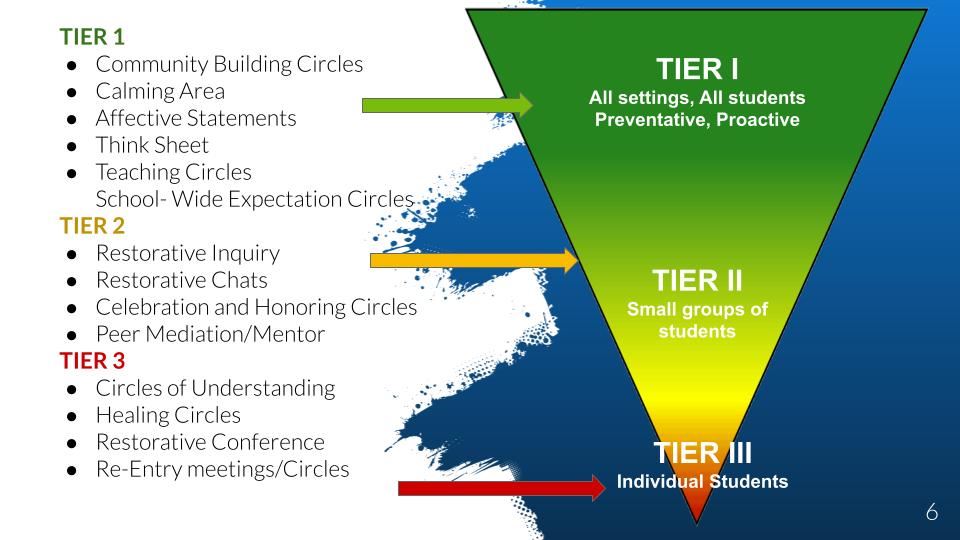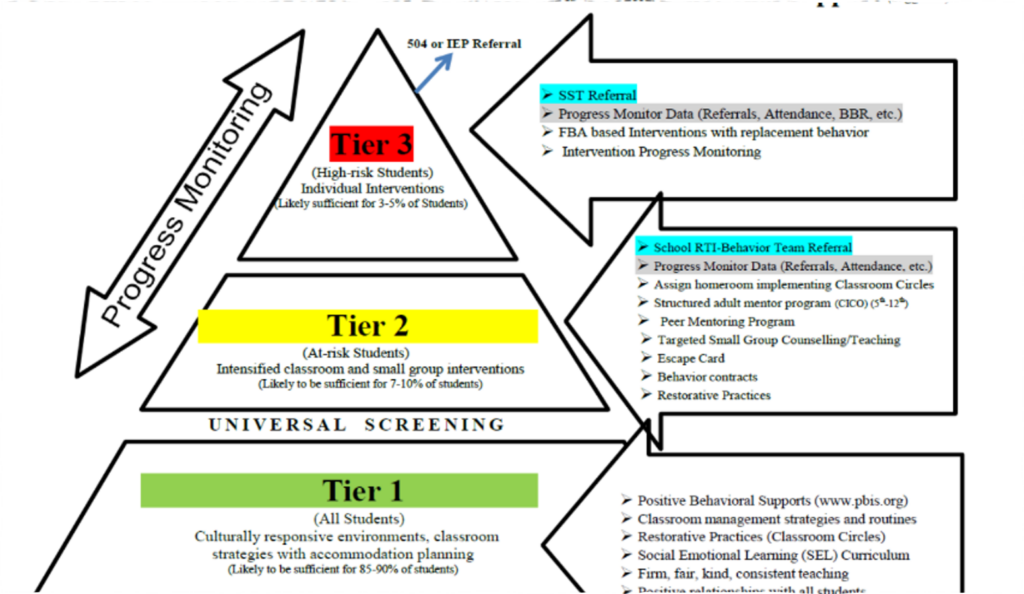Understanding School Discipline Jargon
Resources
Much of the jargon used when discussing disciplining students in k-12 schools sounds benign – virtuous, even – to the average ear. We hear words like “restorative justice” and it sounds like a good thing. And sometimes it is. But often it’s not. Often, when we dig deeper, we discover an explicit effort to dismantle the traditional view of crime and punishment because it’s “racist.” One of the most common complaints is that school discipline practices increasingly focus more on how to support the offender than the victim.
This is frustrating to parents who are watching their children’s schools become increasingly violent. And it only gets more frustrating when their questions are answered with edu-speak and acronyms with which they are not familiar.
Below we provide a very quick and basic list of some of the most commonly used words and phrases when it comes to school discipline. K-12 education is steeped in acronyms so this list should help you better understand what everyone is talking about when they say ISS and SRO.
Code of Conduct
Codes of conduct specify behavior that is accepted or prohibited in the school as well as in any setting that is related to the school. Codes of conduct generally state the behavior expected to be demonstrated by the student. Whether or not schools adhere to what is in their code of conduct is another story.
In School Suspension (ISS)
Temporary removal of a student from his or her regular classroom(s) FOR AT LEAST HALF A SCHOOL DAY. The student remains under the direct supervision of school personnel. Direct supervision means school personnel are physically in the same location as students under their supervision. During the period of suspension, the student is excluded from all school-sponsored activities regardless of location. Suspension days end at midnight.
Positive Behavior Intervention System (PBIS)
Center on Positive Behavioral Interventions and Supports defines PBIS as a “tiered framework for supporting students’ behavioral, academic, social, emotional, and mental health.” The goal for advocates of PBIS is to improve social emotional competence, academic success, and school climate. In summary, PBIS is incentive-based discipline. If a student misbehaves, then promises not to misbehave again, they get something in return. Where PBIS fails is when administrators and teachers are not consistent with the application of the policy. As students see other students who are disruptive in class get these rewards, it incentivizes everyone to be disruptive in order to get the reward. Additionally, students lose interest in the rewards as they become unappealing.
Restorative Justice (Restorative Practices)
Restorative justice is a philosophy for student discipline where reconciliation between the offender and the victim is the ultimate goal. This goal is theoretically achieved by conversations between the offender, the victim and others involved in the incident. While restorative justice practices can be effective when dealing with minor incidents, it is largely ineffective when dealing with more disruptive and violent behavior. In many school districts, restorative justice has REPLACED exclusionary discipline in schools so the response to a violent action in class is not a suspension or expulsion, but to clear the classroom and have a restorative conference.
Here is an example of how a Restorative Justice policy might look in your school district.
From “Understanding Ethnic Studies Jargon”: “Restorative justice is an approach to justice where one of the responses to a misdeed, broken rule or actual crime is to organize a meeting between the victim and the offender, sometimes with representatives of the wider community. In restorative justice, reconciliation, not punishment, is the goal. The “Western” view of crime and punishment is thought to be a byproduct of colonialism.”
Restorative Circles
Students in class sit in a circular formation and are encouraged to be open and honest about their perspectives regarding a conflict, how they have been harmed, and how they think others might have been harmed. Teachers are often not well trained on how to facilitate a practice like this for it to be effective. Students also use what is said in restorative circles to gossip and smear other students, even if there is a promise of confidentiality. Lastly, restorative circles take away precious time for students that could be dedicated to actual learning of material.
Restorative Conferences
A restorative conference is similar to a restorative circle but only includes the offender(s), victim(s) and both parties’ supporters in which they discuss the consequences of the wrongdoing and decide how best to repair the harm. The same problems and challenges exist as in a restorative circle.
Exclusionary Discipline (Punitive Discipline)
Exclusionary discipline is any type of school disciplinary action that removes or excludes students from their usual educational setting. 3 Common examples include in-school suspensions, out-of-school suspensions and expulsions.
School Resource Officer (SRO)
SROs are sworn law enforcement officers responsible for safety and crime prevention in schools.
A local police department, sheriff’s agency, or school system typically employs SROs who work closely with school administrators in an effort to create a safer environment.
Disproportionality in Discipline / Equitable Discipline
This is an effort to address rates in which students of different races are disciplined. For example, if Hispanic students make up 10% of the student population, but Hispanic students have the majority of disciplinary action taken against them in school, this would be considered disproportionate and inequitable discipline. Advocates of Equitable Discipline argue that when minority students are disciplined at a higher rate than other students, this is proof of racial bias and racism.
Disparate Impact
Disparate impact refers to policies, rules, or practices that are blamed for high rates of discipline among racial minorities.
A 2014 letter from President Barack Obama’s Department of Education and Department of Justice that issued guidance to schools to explain that federal law prohibits school discipline that either intentionally or unintentionally results in a disparate impact (see above) based on a student’s race, color, or national origin. Basically, this means that if schools are perceived as disciplining minority students more than other students, federal funding could be pulled from the school.
Multi-Tiered Framework


Multi-tiered system of supports is a prevention program that organizes school level resources to address each individual student’s academic and /or behavioral needs within intervention levels that vary in intensity.
As you can see from the examples above, while this tiered approach is usually supplementary to other discipline policies, it relies on the use of restorative justice techniques (we state the challenges with above), Social Emotional Learning (which we outline problems with here) and “culturally responsive practices” which are typically developed through the lens of critical race theory.
Zero Tolerance Policy
Zero tolerance refers to school discipline policies and practices that mandate predetermined consequences in response to specific types of student misbehavior. These policies include suspensions and expulsions. Critics argue that zero tolerance policies disproportionally affect minority students and therefore should not be used.
Progressive Discipline
Progressive discipline is the process of using increasingly severe steps or measures when a student fails to correct a problem after being given a reasonable opportunity to do so. For example, the first time a student bullies another student, there is a restorative circle, the second time detention, the third time in school suspension, etc.
School-to-Prison Pipeline
The “School-to-Prison Pipeline” (STPP) refers to the perception that school discipline policies and practices that suspend students for severe infractions lead students who are severely disciplined into a life of crime and therefore into the criminal justice system.
Social Emotional Learning (SEL)
CASEL (the leading voice in SEL implementation in schools) defines social emotional learning (SEL) as “the process through which children and adults acquire and effectively apply the knowledge, attitudes and skills they need to understand and manage emotions, set and accomplish positive goals, feel and show empathy for others, establish and maintain positive relationships and make responsible decisions.”
This sounds great – but the focus of SEL shifted in 2020 when SEL became “Transformative SEL”, which we discuss here.
Stay Informed
